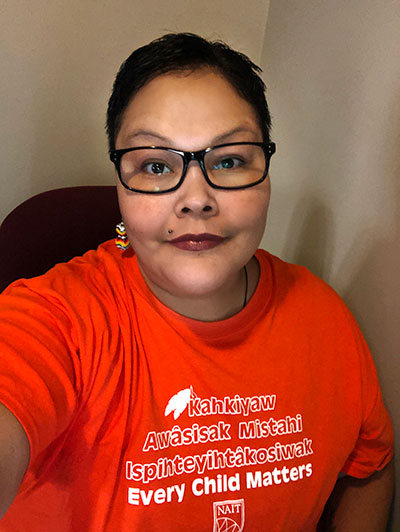“It represents an important day of remembrance”
Phyllis Jack Webstad’s story is woven into an orange shirt lost long ago. When she was six years old, her grandmother gifted her an orange shirt for her first day of school. But her first day at residential school didn’t go as either of them expected. Phyllis’s clothes were taken away from her, including the orange shirt.
The orange shirt was never returned to her, but the colour orange always made Phyllis think of her experiences at a residential school.
“The colour orange has always reminded me of that and how my feelings didn't matter, how no one cared and how I felt like I was worth nothing,” she writes.
“All of us little children were crying and no one cared.”
Orange Shirt Day was inspired by Phyllis’s story and launched in 2013. Its goal is to educate people about residential schools in Canada and to honour and remember the experiences and loss of the First Nation, Inuit and Métis children who were stolen from their families and placed in these schools. Sept. 30 represents the time of year when this happened each year.
Dawn Lameman (Accounting ’12, Bachelor of Business Administration ’16), a member of the support staff at the Nîsôhkamâtotân Centre – where Aboriginal and non-Aboriginal students can gather to network and study (virtually only, currently) – sees Orange Shirt Day as an opportunity to raise awareness of the impact of residential schools.
We asked her what it means to NAIT and what we can do in addition to wearing an orange shirt to honour the stories of Phyllis and roughly 150,000 other First Nation, Inuit and Métis children.
Techlifetoday.ca: What does Orange Shirt Day mean for NAIT?
 Dawn Lameman: Most people with kids in K-12 education may already know some basic tenets of Orange Shirt Day because it’s part of the curriculum.
Dawn Lameman: Most people with kids in K-12 education may already know some basic tenets of Orange Shirt Day because it’s part of the curriculum.
It’s not a requirement in a post-secondary setting, but it’s important to remember the lesson behind that coloured shirt.
It’s not just another coloured shirt that you have to find. It represents an important day of remembrance and part of the reconciliation that every post-secondary has as their calls to action [issued by the Truth and Reconciliation Commission of Canada].
What do you feel is the most important takeaway from the day?
The children of residential schools mattered. Their lives matter. A lot of kids never made it home.
We need to honour their lives and keep the conversation going to prevent this type of cultural genocide from ever happening again. We’re still seeing the negative impact and the longstanding effect of the schools.
How do we continue the conversation after Orange Shirt Day?
The Nîsôhkamâtotân Centre is creating a lot of informative virtual offerings; people can stay tuned to that on our website. They’re free and for NAIT staff and students.
The Four Directions at NAIT
In 2019, NAIT released “Connecting the Four Directions,” a document meant to guide and inspire staff to find ways to honour Indigenous knowledge and to be more inclusive of Indigenous people and communities.
Led by the Nîsôhkamâtotân Centre, it aligns traditional teachings with NAIT’s vision to be a leading polytechnic, and seeks to remove barriers to education.
It was created with input from Elders and cultural advisers from the NAIT community, students, staff at the centre and instructors from across the institute.